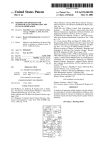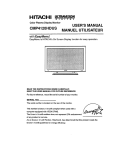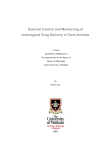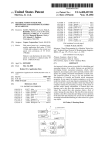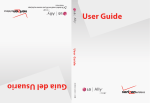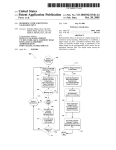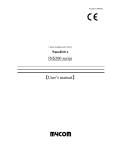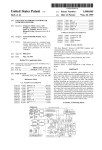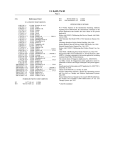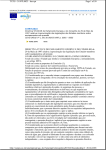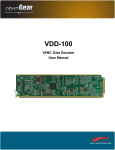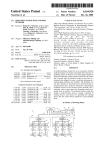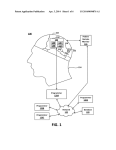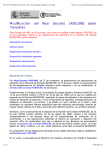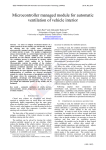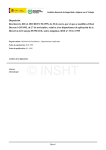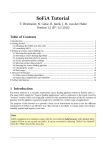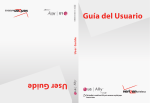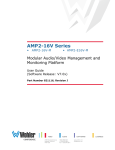Download Systems and methods for communicating with ambulatory medical
Transcript
US006024539A Ulllted States Patent [19] [11] Patent Number: Blomquist [45] [54] [75] Date of Patent: SYSTEMS AND METHODS FOR 4,656,603 4/1987 Dunn . COMMUNICATING WITH AMBULATORY MEDICAL DEVICES SUCH AS DRUG 4,731,051 4,731,058 4,754,401 3/1988 Fischell ~ 3/1988 Doan- _ Inventor: Michael L. Blomquist, Coon Rapids, [*l This patent issued on a continued pros- 0 233 115 9/1987 0 319 272 6/1989 1.53(d), and is subject to the tWenty year patent term provisions of 35 U_S_C_ 154(a)(2)_ European Pat. Off. . France ' OTHER PUBLICATIONS “A Programmable Infusion Pump Controller,” 30th Annual Conference on Engineering in Medicine and Biology, Nov. 5—9, 1977 in Los Angeles, California, 11 pages. [21] Appl- N05 08/868,913 (List continued on neXt page.) Jun‘ 4’ 1997 Primary Examiner—Charles G. Freay - - Related U'S' Apphcatlon Data [63] European Pat 04- - 2 675 288 10/1992 ecution application ?led under 37 CFR [22] Flled: 6/1988 KaCZYIlSkl et al. . FOREIGN PATENT DOCUMENTS Assignee: SIMS Deltec, Inc., 51. Paul, Minn. NOIiCeI *Feb. 15, 2000 (Llst Con?rmed on next page) MiIlIL [73] 6,024,539 Assistant Examiner—Ehud Gartenberg Attorney, Agent, or Firm—Merchant & Gould RC. Continuation of application No. 08/586,952, Jan. 16, 1996, abandoned, which is a continuation of application No. [57] Pat NO_ 5338 157_ n1cat1ng W1th ambulatory to medical devices, such as drug 7’ 7 ABSTRACT delivery devices, both locally and remotely. In one [51] Int. Cl. .................................................... .. F04B 41/06 embodiment, a Caregiver drug pump Communicates With a [52] US. Cl. ........................... .. 417/63; 364/188; 395/340 Of Search .................................. .. 53, remote patient drug pump for data gathering, trouble Shooting, and Operational program Changes_ The Caregiver 364/ 188; 702/81, 122; 128/904; 345/340, 348, 349, 350, 351 drug pump is substantially identical in con?guration to the patient drug pump. The caregiver drug pump transmits caregiver key input signals to the remote patient drug pump. The patient drug pump receives the key input signals, [56] References Cited accesses a desired program, and transmits information for US' PATENT DOCUMENTS 112947733 3/1988 Peterson et a1__ display on the display of the caregiver drug pump. In another embodiment, a computer is provided for communicating 4,091,550 5/1978 shrenk et a1_ _ locally and/or remotely With a drug pump. The computer 4,098,267 4,396,977 7/1978 Stein et al. . 8/1983 Slater et al. . may include a display With an image of a pump. The computer may be operated through the use of a mouse or 4,413,314 11/1983 Slater et a1-475597038 12/1985 Berg et al' 4’565’542 1/1986 Berg ' touch screen With respect to the image of the pump, to simulate use of the pump While using the personal computer. The computer may also be used as a training aid for training 4,606,353 476247661 8/1986 TlIIlIIl . 11/1986 Arimond _ 4,649,499 3/1987 Sutton et al. . 4,650,469 3/1987 Berg et al. . . . a careglver and/or pat1ent hoW to use the drug pump. 13 Claims, 10 Drawing Sheets 6,024,539 Page 2 “Product Overview, Verifuse Ambulatory Infusion Pump,” US. PATENT DOCUMENTS 4,756,706 4,778,449 Block Medical Inc., dated Sep. 1990, 4 pages. Peter Lord et al. “MiniMed Technologies Programmable 7/1988 Kerns et al. . 10/1988 Weber et al. . 4,810,243 3/1989 4,832,033 4,847,764 4,889,132 4,898,578 5/1989 7/1989 12/1989 2/1990 Howson .................................. .. 604/31 Maher et al. . Halvorsen . Hutcheson et al. . Rubalcaba . Implanatable Infusion System,”pp. 66—71, from Annals of the New York Academy of Sciences, Neurological Applica tions of Implanted Drug Pumps, copyright 1988. DertouZos, M., “Communications, Computers & Net works,” Scienti?c American Sep. 1991, pp. 62—69. 4,901,221 2/1990 Kodosky et al. . Dehne, T., “PC—Based Data Acquisition and Instrumenta 4,918,930 4/1990 Gaudet et al. ......................... .. 62/55.5 4,925,444 4,933,873 5/1990 Orkin et al. . 6/1990 Kaufman et al. . tion,”Analytical Chemistry, vol. 62, No. 9, May 1, 1990, pp. 565A, 566A, 568A, 570A, 571A, 572A. 4,942,514 7/1990 Miyagaki et al. . 4,954,818 4,957,690 4,970,664 5,032,978 5,038,800 5,078,683 5,084,828 5,100,380 5,116,312 9/1990 9/1990 11/1990 7/1991 8/1991 1/1992 “allyTM Ambulatory Drug Infusion System”, Q—Life Sys tems Inc., 3 pages. Nakane et al. . Fennern . Kaiser . Watson et al. . Oba . Sancoff et al. . Fundamentals of Interactive Computer Graphics, Foley et al., Mar., 1993, pp. 10, 11, 29—35. Imed Status Infusion Management System literature, 6 pages. Linkens et al., Computer Control Systems and Pharmaco 1/1992 Kaufman et al. . logical Drug Administration: A Survey, Journal of Medical Engineering & Technology, vol. 14, No. 2, Mar./Apr. 1990, 3/1992 Epstein et al. . 5/1992 Blankenship et al. . pp. 41—54. 5,131,816 5,153,827 7/1992 Brown et al. . 10/1992 Coutre et al. . 5,155,693 10/1992 Altmayer et al. . tems,” Design News, May 21, 1990, pp. 72—73. 5,157,928 10/1992 Gaudet et al. ......................... .. 62/55.5 National Instruments Document entitled “Scienti?c Data 5,168,441 5,172,698 12/1992 Onarheim et al. . 12/1992 Stanko . Analysis,” 16 pages. National Instruments’ 1990, 20 pages. National Instruments’ 1991, 20 pages. National Instruments’ 1990, 18 pages. National Instruments’ 1990, 16 pages. 5,176,004 5,190,442 1/1993 3/1993 5,207,642 5/1993 Orkin et al.. 5,224,051 5,230,623 6/1993 Johnson . 7/1993 Guthrie et al. . 5,241,461 8/1993 Georges . 5,247,434 5,256,157 5,291,190 5,295,062 5,301,301 9/1993 10/1993 3/1994 3/1994 McCarthy, L.H. “Software Simulates Instrumentation Sys Gaudet .................................. .. 417/901 Jorritsma ................................. .. 417/12 Peterson et al. . Samiotes et al. . Scarola et al. . Fukushima . Instrumentation Newsletter, Feb. Instrumentation Newsletter, May Instrumentation Newsletter, Nov. National Instruments LabWindows 2.0 materials, 6 pages. National Instruments LabWindows 1.2 materials dated Oct., 1989, 5 pages. 4/1994 Kokosky . 5,315,530 5,321,601 5,353,316 5,363,482 5/1994 6/1994 10/1994 11/1994 5,376,070 12/1994 Pun/is et al. ............................ .. 604/31 5,386,360 5,400,246 5,412,400 5,432,709 5,479,643 5,481,250 1/1995 3/1995 5/1995 7/1995 12/1995 1/1996 5,485,408 Instrumentation Newsletter, Aug. Gerhardt et al. . Riedel et al. . Scarola et al. . Victor et al. . Bedder, M. et al., “Cost Analysis of Two Implantable Narcotic Delivery Systems,” Journal of Pain and Symptom Management, vol. 6, No. 6, Aug., 1991, pp. 368—373. Wilson et al. . Wilson et al. . Takahara et al. . Vollweiler et al. . Bhaskar et al. . Hano . Sheppard, L.C., Computer—based Clinical Systems: Auto mation and Integration, 39th Annual Conference on Engi neering in Medicine and Biology, Baltimore, Maryland, Sep. 13—16, 1986, pp. 73—75. Principles and Guidelines in Software User Interface Design, Deborah J. Mayhew, Chapter 9 Dialog Styles: Direct Manipulation, copyright 1992, 17 pages. 1/1996 Blomquist . 5,718,562 2/1998 Lawless et al. 5,719,761 2/1998 Gatti et al. ............................ .. 364/130 417/1 OTHER PUBLICATIONS Advertisement from HERCO, “Are Control Rooms Obso lete?” dated Mar., 1971, 1 page. Advertisement from HERCO, “Are Control Rooms Obso lete?”, dated Mar., 1972, 1 page. “Block Medical: Growing with Home Infusion Therapy,” In Vivo, The Business and Medicine Report, Apr. 1991, 3 Electronics Feb. 1990 article entitled “Who Will Dominate pages. Designing the User Interface, Ben Shneiderman, Chapter 5 Direct Manipulation, Oct., 1993, 56 pages. The Orange County Register, Nov. 21, 1991 article entitled Abbott Literature, 37 pages. Baxter literature for MultiPlexTM Series 100 Fluid Manage ment System, 2 pages. Baxter literature for MultiPlexTM Series 100 Fluid Mange ment System, copyright 1988, 2 pages. Baxter literature for Flo—Gard® 6201 Volumetric Infusion Pump, copyright 1992, 2 pages. San Diego Executive, “A Better Mousetrap,” Sep., 1989, pp. 8—10. Blade—Citizen, “Entrepreneur takes aim at home health care market,” Dec. 31, 1989, 2 pages. the Desktop in the ’90s?”, 3 pages. “Portable IV frees patients,” 1 page. Article by McMorris, et al., “Are Process Control Rooms Obsolete?”, Control Engineering, dated Jul., 1971, pp. 42—47. LabVIEW®2 User Manual, Jan. 1990 Edition, cover page and pp. 2—1 through 2—36. National Instruments’ 1991 catalog entitled “IEEE—488 and VXIbus Control, Data Acquisition, and Analysis,” cover page and pp. 1—1 through 1—13, 1—38, 4—68, and 4—69. 6,024,539 Page 3 Abbott Laboratories Blue Line System Life Care® Model 4 Series System brochure, copyright 1990, 16 pages. Video tape—University of Maryland at College Park MD. Hurnan—Cornputer Interaction Laboratory, Apr, 1991. Video tape—University of Maryland at College Park MD. Hurnan—Cornputer Interaction Laboratory, Apr, 1992. U.S. Patent Feb. 15,2000 Sheet 1 0f 10 6,024,539 10 FIG. 1 I'l-u FIG. 2 (so / 'l C I 2 100-7 if 54 U.S. Patent Feb. 15,2000 Sheet 2 0f 10 FIG. 1A 40-\ F 46' f 42 41--\ 420 \ 46G f ‘5 \_ 450 I 4'90 /— 430 > /— 4-4-0 6,024,539 U.S. Patent Feb. 15,2000 Sheet 3 0f 10 6,024,539 FIG. 3 r 0 62 100 U.S. Patent Feb. 15,2000 Sheet 4 0f 10 6,024,539 PATIENT PUMP INITIAUZATION IS PATIENT PUMP IN SLAVE MODE PUMP MODE PUMP OPERATES NORMALLY ? PATIENT PUMP MECHANISM DISABLED HAS KEY INPUT SIGNAL BEEN RECEVED FROM CAREGNER PUMP‘? KEY INPUT SIGNAL RUNS PROGRAM IN PATIENT PUMP I PROGRAM UPDATES DISPLAY ON PATIENT PUMP I DISPLAY SIGNAL SENT TO CAREGNER PUMP FIG. 4 U.S. Patent Feb. 15,2000 Sheet 5 0f 10 6,024,539 250 \ CAREGIVER PUMP INITIAUZATION IS CAREGIVER' PUMP IN MASTER MODE ? “0 PUMP OPERATES NORMALLY CAREGIVER PUMP MECHANISM DISABLED HAS KEY BEEN PRESSED 0N CAREGNER PUMP ? KEY INPUT SIGNAL SENT TO PATIENT PUMP HAS DISPLAY SIGNN. BEEN RECEIVED FROM PATIENT PUMP DISPLAY SIGNAL UPDATES DISPLAY ON CAREGNER PUMP FIG. 5 U.S. Patent Feb. 15,2000 Sheet 6 0f 10 6,024,539 300 ( 302 304 I CAREGNER PUMP CAREGIVER CONNECTS CAREGIVE? MODEM CABLE TO CAREGIVER PUMP AND INSTRUCTS PATIENT TO CONNECT PATIENT MODEM CABLE TO PATIENT PUMP. PUMP TELLS MODEM TO TURN ON SPEAKER CAREGIVER ASKS PATIENT TO VERIFY THAT PATIENT PUMP HAS RESPONDED WITH "PRESS ENTER TO START SLAVE COMMUNICATIONS" MESSAGE ON THE DISPLAY. CAREGNER INSTRUCTS w PATIENT PUMP PATIENT CONNECTS PATIENT MODEM CABLE TO PATIENT PUMP PATIENT TO PRESS ENTER KEY. THEN. WITHOUT HANGING UP THE PHONE. TO LISTBI FOR FURTHER INSTRUCTIONS. COMING FROM THE MODEM SPEAKER. PATIENT PRESSES ENTER KEY PUMP TELLS MODEM TO START SLAVE COMMUNICATIONS. PUMP STARTS TWO MINUTE TIME OUT WHILE WAITING FOR CARRIE? DETECT FROM MODEM. MODEM GOES OFF-HOOK MODEM DISCONNECTS PHONE MODEM TURNS ON SPEAKER MODEM SENDS SHORT BEEP TO CAREGNER PUMP THEN USTBIS FOR CARRIER FIG. 6A U.S. Patent Feb. 15,2000 Sheet 7 0f 10 6,024,539 300 T 302 I 304 T CAREGIVH? HEARS SHORT MODEM BEEP PATIENT SETS PHONE DOWN EITHER FROM PHONE HANDPIECE OR WITHOUT HANGING UP MODEM SPEAKER AND KNOWS THAT THE PATIENT PUMP IS READY CAREGNER PRESSES ENTER KEY PUMP TELLS MODEM TO START MASTER COMMUNICATIONS, THEN PUMP WAITS FOR INCOMING DATA. PUMP STARTS TWO MINUTE TIME OUT WHILE WAITING FOR RESPONSE FROM PATIENT PUMP MODEM GOES OFF-HOOK MODEM DISCONNECTS PHONE MODBA SDIDS CARRIER cAREGIvER SETS PHONE DOWN MODEM RECEIVES CARRIER, THEN wrrHour HANGING UP SENDS "CARRIER RECEIVE)" sIGNAL T0 PATIENT PUMP PUMP TELLS MODEM T0 SHUT OFF SPEAKER MODBII SHUTS OFF SPEAKER PUMP SENDS "I'M HERE" SIGNAL TO CAREGNER PUMP PUMP ACKNOWLEDGES "I'M HERE" SIGNAL AND SENDS "OK TO BEGIN" SIGNAL TO PATIENT PUMP PUMP TELLS MODEM To SHUT OFF SPEAKER MODEM SHUTS OFF SPEAKER PUMP SENDS KEY INPUT SIGNALS T0 PATIBIT PUMP PATIBIT PUMP RECEVES "OKAY TO BEGIN" SIGNAL AND SENDS CURRENT DISPLAY SIGNAL TO CAREGNER PUMP PUMP SENDS DISPLAY SIGNALS T0 CAREGNER PUMP IN RESPONSE TO KI-Y INPUT SIGNALS FIG. 6B U.S. Patent Feb. 15,2000 ( 4-02 . Sheet 8 0f 10 I CAREGNER PUMP CAREGNER PRESSES STOP/START KEY PUMP SENDS- "DISCONNECT" SIGNAL TO PATIENT PUMP PUMP SBIDS "DISCONNECT" SIGNAL TO MODEM MODEM CUTS CARRIER MODEM CONNECTS PHONE MODEM TURNS ON SPEAKER 4-04 6,024,539 w PATIENT PUMP PUMP ACKNOWLEDGES "DISCONNECT‘ SIGNAL PUMP BEGINS TO BEEP PUMP SBIDS "DISCONNECT" SIGNAL TO MODEM MODEM CUTS CARRIER MODEM CONNECTS PHONE MODEM TURNS ON SPEAKER CAREGNER UNPLUGS CAREGNER MODEM CABLE MODEM DISCONNECTS SPEAKER MODEM GOES ON HOOK CAREGNER PICKS UP PHONE THEN CALLS FOR PATIENT TO PICK UP PHONE. PATTENT HEARS CAREGNER IN MODEM SPEAKER AND PICKS UP PHONE CAREGNER TELLS PATTENT TO DISCONNECT PATIENT MODEM CABLE PATTENT DISCONNECTS PATIENT MODEM CABLE PUMP STOPS BEEPING MODEM DISCONNECTS SPEAKER MODEM GOES ON HOOK CAREGNER RESUMES NORMAL VOICE COMMUNICATIONS PATTENT RESUMES NORMAL VOICE COMMUNICATIONS FIG. 7 U.S. Patent Feb. 15,2000 (502 Sheet 9 0f 10 I CAREGNER PUMP PUMP RECEIVES PAGE AND DISPLAYS PATIENT PAGING MESSAGE CAREGNER PRESSES STOP/START KEY PUMP SENDS "DISCONNECT" SIGNAL TO PATIENT PUMP PUMP SENDS "DISCONNECT" SIGNAL TO MODEM MODEM CUTS CARRIER MODEM CONNECTS PHONE MODEM TURNS ON SPEAKS! 6,024,539 504w PATIENT PUMP PATIENT PRESSES STOP/START KEY PUMP SENDS PAGE TO CAREGNER PUMP PUMP ACKNOWLHDGES "DISCONNECT" SIGNAL PUMP BEGINS TO BEEP PUMP SENDS "DISCONNECT" SIGNAL TO MODEM MODEM CUTS CARRIER MODEM CONNECTS PHONE MODEM TURNS ON SPEAKER CAREGNER UNPLUGS CAREGNER MODEM CABLE MODEM DISCONNECTS SPEAKER MODEM GOES ON HOOK CAREGNER PICKS UP PHONE THEN CALLS FOR PATIENT TO PICK UP PHONE. PATIENT HEARS CAREGNER IN MODEM SPEAKER AND PICKS UP PHONE CAREGNER TELLS PATIENT TO DISCONNECT PATIENT MODEM CABLE PATIENT DISCONNECTS PATIENT MODEM CABLE PUMP STOPS BEEPING MODEM DISCONNECTS SPEAKER MODEM GOES ON HOOK CAREGNER RESUMES NORMAL VOICE PATIENT RESUMES NORMAL VOICE COMMUNICAIIONS COMMUNICATIONS FIG. 8 U.S. Patent Feb. 15,2000 Sheet 10 0f 10 6,024,539 FIG. 9 FIG. 10 98 U > 92 OOO OOO 6,024,539 1 2 SYSTEMS AND METHODS FOR COMMUNICATING WITH AMBULATORY MEDICAL DEVICES SUCH AS DRUG DELIVERY DEVICES There may further arise a need for the caregiver to access the controller, such as the processor and the programs, Which controls operation of the ambulatory medical devices. For example, in the case of drug delivery devices, some thera pies change over time. The caregiver may need to access the operating program in order to change the operation of the This is a Continuation of application Ser. No. 08/586, 952, ?led Jan. 16, 1996 noW abandoned, Which is a Con drug delivery device. Further, some drug delivery devices, for example, may be used for very different applications, tinuation of patent application Ser. No. 08/276,025, ?led Jul. 15, 1994, noW issued as US. Pat. No. 5,485,408, Which is a Continuation of patent application Ser. No. 07/942,288, ?led Sep. 9, 1992, noW issued as US. Pat. No. 5,338,157. requiring different operating programs. These operating pro 10 FIELD OF THE INVENTION The present invention relates generally to ambulatory medical devices and methods for communicating With such 15 devices. In particular, the present invention relates to sys tems and methods for locally and remotely communicating With drug delivery devices. BACKGROUND OF THE INVENTION Various ambulatory medical devices are knoWn for treat the drug pump. The caregiver may visit the patient at the patient’s home at some point after the drug therapy has begun using the drug pump. The caregiver may sample the 20 patient’s blood. The caregiver returns to the of?ce and the 25 blood sample is analyZed. The results of the blood analysis may indicate the patient is not receiving the proper drug therapy. This usually means the controller of the drug pump must be adjusted to give the proper therapy to the speci?c patient. To adjust the controller, the caregiver needs to be ing and/or monitoring patients at a remote site aWay from the caregiver’s or clinician’s office. One eXample of an ambu latory medical device is a drug delivery device, such as a drug pump, for providing periodic or continuous drug deliv ery to the patient When the patient is aWay from the caregiver’s office. Certain drugs rarely achieve their maXimum therapeutic action through conventional injection techniques. Many drugs reach their full potential only through precise delivery able access the controller. Another problem facing caregivers in the area of ambu latory medical devices relates to the ease of remote com 30 over an eXtended period of time. With controlled drug infusion through a drug pump, the drug can be given at a precise rate that Will keep the drug concentration Within the therapeutic margin and out of the toXic range. Ambulatory drug pumps can provide appropriate drug delivery to the 35 hospital or caregiver’s of?ce. A failure to adequately monitor the drug pump and the delivery therapy. In some cases, the drug therapies can have serious health consequences to the patient if the drugs are not administered properly. Several concerns arise When the patient utiliZes the vari 45 In the case of remote communication With a patient’s medical device using a personal computer/base station, the caregiver also needs to remain near the personal computer/ base station, or else transport the personal computer/base station With the caregiver, if the caregiver Wishes to remain in communication With the patient’s medical device. It sometimes may become necessary to communicate With a personal computer or base station either locally or ambulatory medical device gathers data With respect to the device and/or the patient, the data needs to be easily acces sible by the caregiver to permit the caregiver to monitor the device and the patient. Often, the patient may be of little or no assistance in accessing the data and communicating With the caregiver from the remote site. If the caregiver needs to remotely in order to take advantage of the greater data handling or processing capability of the personal computer 55 or base station, for eXample. The ability of the caregiver to communicate easily With the pump using a personal com puter or base station may be important in those circum stances. In addition, the patient may be able to do very little to assist the caregiver in linking the remote medical device to the local personal computer/base station. There is a need for systems and methods for communi cating With ambulatory medical devices such as drug deliv ery devices, both locally and remotely, Which addresses the visit the patient. If the caregiver attempts to trouble shoot from a remote site, the patient may be unable physically or medical device. The caregiver must then be knowledgeable both in operation of the medical device and in operation of the personal computer/base station. This concern also applies to local communication With the ambulatory medical device. 40 ous ambulatory medical devices at remote sites. If the physically handle the device to access the data, the device and caregiver must be brought to the same location. Similar problems can also arise in that the medical devices may fail or be used improperly at the remote sites. If the device is not operating properly, the device may have to be brought to the caregiver, or the caregiver may have to munication With the devices, if such remote communication capability is provided. Remote communication With an ambulatory medical device using a personal computer or base station may be dif?cult for some caregivers, if the personal computer/base station operates differently than the patient at a controllable rate Which does not require frequent medical attention and Which alloWs the patient to leave the patient’s usage of the drug pump can reduce or eliminate any bene?ts the patient may have received from a proper drug grams can be changed as the use of the drug delivery device changes. Resources may not be used ef?ciently if the car egiver and the device must be brought to the same location for the caregiver to access the processor and operating programs. One speci?c situation often arises in the case of a drug pump Where the caregiver needs to access the controller of above concerns and other concerns. 60 mentally to suf?ciently cooperate With the caregiver for the SUMMARY OF THE INVENTION caregiver to trouble shoot from the remote site. Operating The present invention relates to systems and methods for communicating With an ambulatory medical device, such as a drug delivery device, and in particular, a drug pump. In one embodiment, a communication system is provided Where a remote drug pump communicates With a similar local drug pump. Each of the drug pumps are provided With a pump problems can arise at inconvenient times, such as at night or on Weekends and holidays. The caregiver may also need to be able to easily periodically monitor the patient’s usage of the medical device to observe patient compliance With prescribed treatments While the patient is at the remote site. 65 6,024,539 4 3 controller for controlling operation of the pump. The con In one embodiment, the caregiver pump and the patient pump both include program means for operating in both the master and slave modes. Automatic selection of the master or slave mode from the normal pumping mode is provided When a communications cable is connected to the respective pump. troller may include a processor and associated memory for storing operating programs and other information. The pumps each include a pumping mechanism controlled by the controller for pumping ?uid to a patient in the normal pumping mode of operation. Interconnect structure, such as modems, is provided to permit interconnection of the controllers of the pumps in the pump to pump communications mode of operation. The interconnect structure permits communication betWeen the Various program means and sequences are disclosed for communication betWeen the local caregiver pump and the remote caregiver pump to facilitate e?icient communication 10 While emphasiZing easy usage by the caregiver and by the patient, some of Whom may have di?iculty carrying out instructions from the caregiver over the telephone. In another embodiment, systems and methods are pro respective processors over a communications medium, such as conventional telephone communication lines. The tele phone lines also permit initial voice communication betWeen the patient and the caregiver using conventional telephones vided for communicating betWeen a remote pump and a or other devices before the pumps are linked together for the 15 local caregiver computer, such as a personal computer. Such pump to pump communications mode of operation. The communication may permit greater data processing utiliZing modems may include speakers to facilitate ease of operation the computer’s data handling capability. Also, communica during pump to pump communication With patients Who have di?iculty in cooperating With the caregiver due to mental and/or physical limitations. Each drug pump includes operator input structure for making operator inputs to the controller of the respective pump. The operator input structure is useful for selecting tion With the remote pump using the local computer may be useful for recertifying the remote pump periodically as is sometimes required With respect to medical devices. The local computer may also be useful in changing or adjusting the pump operations program of the remote pump. Modem desired pump control programs or desired pump data or both communications medium, such as conventional telephone lines, betWeen the remote pump and the local computer. from the memory of the processor of the pump. The infor mation selection structure may include a keypad comprising communication structure permits communication over a 25 In a further embodiment, modem communication struc a plurality of keys. ture is provided Which links a local pump to a local com puter. Preferably, the modem communication structure also includes structure for further permitting communication Display structure on each pump is interconnected to the controller of the respective pump. The display structure displays information about operations of the pump sent to the display structure by the controller. The display structure may display desired information from the memory of the betWeen the local computer or the local pump and a remote processor, such as information relating to the normal pump ing operations mode of the pumping mechanism. Other information that may be displayed may relate to various sensor outputs to the controller. Other information displayed 35 may relate to the pump to pump communications mode. The display structure may include an LCD dot matrix display. tWo pumps to communicate in such a Way during pump to pump communications that one pump controls the functions likely already familiar With operation of the patient pump, thereby saving training time because the caregiver pump operates similarly to the patient pump. Further, the caregiver In another embodiment of the invention, a computer system is provided, With a processor and memory, Which is programmed to display an image of a pump on a display that resembles the pump utiliZed by the patient. The image includes representations of the keys and the display of an actual pump. The computer is further programmed such that Information programmed into the controllers alloWs the of the other. Information programmed into the local drug pump, or caregiver pump, instructs that the caregiver pump be put into the master mode at some point during operation. In the master mode, the local caregiver pump sends its keyboard inputs to a remote patient pump. The caregiver pump also receives its display inputs from the remote patient pump. The caregiver pump is used by the caregiver for such purposes as data gathering, trouble shooting, and operational program changes With respect to the remote patient pump. Ease of communication is provided since the caregiver is pump. This modem communication structure permits: (1) local pump and local computer communication; (2) local pump and remote pump communication; and (3) remote pump and local computer communication. the image of the pump is utiliZed to communicate With an actual remote pump or an actual local pump by manipulating 45 or activating the keys on the image of the pump. The keys of the image can be activated by such techniques as through the use of a mouse or a touch screen. Activating the keys of the image of the pump simulates for the caregiver the presence of an actual pump. This facilitates reductions in training time for training the caregiver to communicate With the patient’s pump, since the caregiver is most likely already familiar With operation of the patient’s pump. The computer system With the pump image program may also be used as a simulator for training the caregiver or the patient hoW to use the pump. The simulator includes various 55 can remain in constant communication With the patient pump by merely transporting the caregiver pump and a modem With the caregiver at all times. The remote patient pump has information programmed into the controller that instructs the patient pump to be put into the slave mode at the appropriate time. In the slave programs for simulating for the patient trainee and/or the caregiver trainee various pump operations situations With a patient’s pump for pumping ?uid. The simulator also includes various programs for simulating for the patient trainee and/or the caregiver trainee various communication situations With a patient’s pump. These and other features of the present invention are mode, the patient pump receives its keyboard input signals described in greater detail in the detailed description of the primarily from the caregiver pump. The patient pump sends preferred embodiments. its display signals to the caregiver pump. In one embodiment, the slave mode of the patient pump disables the patient pump from actually pumping the ?uid during communication With the caregiver pump. 65 BRIEF DESCRIPTION OF THE DRAWINGS In the draWings, Where like numerals refer to like features throughout the several vieWs: 6,024,539 5 6 FIG. 1 is a schematic diagram illustrating a ?rst system of local pump and remote pump communications. FIG. 1A is a schematic diagram illustrating components of the remote pump shoWn in FIG. 1. FIG. 2 is a schematic diagram illustrating a second system using a personal computer to communicate With a local patient. Speci?c components of patient pump 40 are shoWn in greater detail in FIG. 1A. Caregiver pump 20 is preferably pump and/or a remote pump. Local pump and remote pump ?uid communication structure 47a, such as a tube. The ?uid reservoir 47 may be a cassette mounted to pump 40, or the ?uid reservoir may be a container located at a remote site from pump 40, both interconnected to pump 40 With a ?uid communication tube 47a. To pump ?uid to a patient, the identical to patient pump 40 With respect to the features shoWn in FIG. 1A. Pump 40 as shoWn in FIG. 1A includes a pumping mechanism 43 and a ?uid reservoir 47 interconnected by a communications capability is also shoWn. FIG. 3 is a schematic diagram of a modem useful in the communication system shoWn in FIG. 2 to interconnect a personal computer, a local pump, and a remote pump. FIG. 4 is a ?oW chart of an operational sequence of the patient pump With respect to the normal pumping mode for pumping ?uid and the slave mode for pump to pump communication. FIG. 5 is a ?oW chart of an operational sequence of the 10 15 pump is also interconnected to the patient, such as through a tube 40a. The pumping mechanism 43 pumps ?uid from the reservoir 47 to the patient through the tube 40a inter connected to the patient. Pumps 20,40 may be any of a variety of drug delivery pumps. An eXample of one drug delivery pump is described in US. Pat. No. 4,559,038, incorporated herein by reference. In US. Pat. No. 4,559,038, a rotating camshaft is provided Which engages tWo reciprocating valves and a reciprocating eXpulser. The valves and eXpulser engage a tube intercon caregiver pump With respect to the normal pumping mode for pumping ?uid and the master mode for pump to pump communication. FIGS. 6A and B comprise a single ?oW chart of opera tional sequences involving the caregiver pump and the patient pump during connection and communication betWeen the caregiver pump and the patient pump When the nected in ?uid communication betWeen a ?uid reservoir and patient pump is located at a remote site. FIG. 6B folloWs 25 after FIG. 6A during operations. the patient. The rotating camshaft moves the valves and eXpulser to pump ?uid through the tube. In the communication system 10 of FIG. 1, only patient Wants to discontinue communication betWeen the caregiver pump and the patient pump at some time during remote pump 40 is utiliZed to pump ?uid to the patient. Caregiver pump 20 is used by the caregiver to communicate With patient pump 40. Caregiver pump 20 is preferably not used to pump ?uid during pump to pump communication With communication betWeen the caregiver pump and the patient patient pump 40. HoWever, caregiver pump 20 could be used FIG. 7 is a ?oW chart of operational sequences involving the caregiver pump and the patient pump When the caregiver to pump ?uid to a patient before or after communication pump. FIG. 8 is a ?oW chart of operational sequences involving the caregiver pump and the patient pump When the patient Wishes to speak to the caregiver at some time during remote 35 Pumps 20,40 each include a controller for controlling operation of the pumping mechanism utiliZed to pump ?uid. Pump 40 shoWn in greater detail in FIG. 1A includes a controller 41 interconnected to pumping mechanism 43 through connection structure 43a. The controller 41 prefer ably includes a processor and memory programmable With communication betWeen the caregiver pump and the patient pump. FIG. 9 is a schematic diagram shoWing a computer screen displaying an image of a pump, as part of a computer system used for communicating With a pump. FIG. 10 is a schematic diagram shoWing a second com puter screen displaying an image of a pump, as part of a selected functions for controlling operation of the pumping mechanism 43. As shoWn in FIG. 1A, the controller 41 is computer system, and including information displayed on the screen relating to simulation sequences for use in train mg. With patient pump 40, should the need arise. In some cases, caregiver pump 20 could be used to pump ?uid during pump to pump communications With patient pump 40. also connectable to one or more electrical sensor elements in 45 the pump, such as sensors 45,49. A variety of sensors like sensor 45 may be provided depending on the type of pump and the intended usage of the pump. For example, since the ?uid is pumped through a tube 40a to the patient by the pump, the pump may include a DESCRIPTION OF THE PREFERRED EMBODIMENTS Referring noW to FIG. 1, a system 10 of communication betWeen a local drug pump 20 (or caregiver pump) and a doWnstream high pressure sensor to detect When an occlu remote drug pump 40 (or patient pump) is shoWn. In system sion of the tube has occurred. A sensor may also be provided 10, local pump 20 is functioning as a caregiver pump for use to sense When a vacuum develops in tube 47a upstream from by the caregiver at the site 32 Where the caregiver is located, the pump betWeen the pump mechanism 43 and the ?uid reservoir 47, indicating a lack of ?uid to be pumped. Other such as the caregiver’s office. Site 32 may be the caregiver’s home, during on call periods, or even the caregiver’s automobile, if the automobile is provided With some com 55 sensors may be provided to sense pump electrical poWer supply status. Still other sensors may be provided to monitor munications capability for sending and receiving signals the operation of the mechanical components comprising the With respect to another site. In system 10, the caregiver operating pump 20 is typically a nurse, physician, therapist, ambulatory patient pump for pumping drugs to the patient pumping mechanism. The sensors, like sensor 45, all typi cally send a suitable electrical signal to the processor of controller 41 through connection structure, like structure 45a, indicative of the conditions sensed. The controller is appropriately programmed to receive and process the sensor and is located With the patient at a site remote from caregiver pump 20, such as at the patient’s home 52. Also, site 52 may signals it receives. Sensor 49 relates a particular sensor useful during pump to pump communications to assist the or other medical personnel. In system 10, remote pump 40 is functioning as an be the patient’s Workplace. Pumps 20,40 each include a pumping mechanism Which is capable of pumping ?uid from a ?uid reservoir to a 65 operators (both patient and caregiver) in communication betWeen the pumps, Which Will be discussed in greater detail beloW. 6,024,539 7 8 The controller 41 includes memory for storing various programs and data related to operation of the pump. The modem 28 located locally With respect to caregiver pump 20. Caregiver pump 20 is interconnected to modem 28 processor runs the desired operating programs to control through connection structure 30, such as an RS232 serial cable. Caregiver pump 20 and modem 28 may be located at operation of the pumping mechanism 43. The processor further responds to the sensor input signals by generating appropriate control output signals in accordance With its programmed control logic. Access to the processor is pro the caregiver’s office 32, at the caregiver’s home during on-call periods, or even at a mobile site, such as the caregiver’s automobile. vided through an external communication port 42. For caregiver pump 20, access to the processor is provided through an external communication port 22 (see FIG. 1). Both caregiver pump 20 and patient pump 40 can be utiliZed for pumping or delivering a drug to a patient When Communication port 42 permits interconnection of the controller of patient pump 40 to modem 48 With connection 10 structure 50, such as an RS232 serial cable. Patient pump 40 and modem 48 are both located remotely to caregiver pump 20 and modem 28, such as at the patient’s home or Work the respective pump is interconnected to the patient. Pumps place 52, or other location remote from caregiver pump 20. Communication betWeen pump 20 and pump 40 through 20,40 are preferably identical With respect to the electrical and the mechanical ?uid pumping functions. One advantage of this is that caregiver pump 20 can be an unused spare 15 modems 28,48 is over communications medium 54 such as conventional telephone lines, cellular phones, ?ber optics patient pump 40. As Will be discussed beloW, the respective controllers of pumps 20,40 may be programmed differently links, satellite links, microWave links, or other. Modems 28,48 preferably communicate at 9600 bps and include error correction and data compression features over conventional to operate in the appropriate desired manner during pump to pump communications. As Will also be discussed, this telephone lines. programming can be done locally or remotely. Preferably, pumps 20,40 include appropriate programs to operate either One advantage of the present invention is that the car egiver can communicate With the patient pump 40 using a similar pump, the caregiver’s pump 20. The caregiver pre as a master pump or as a slave pump during pump to pump communications. In some cases, the programs in each pump that control operation of the pumping mechanism Will be different. This Will also be discussed in more detail beloW. 25 communicate With patient pump 40 to access the processor of patient pump 40 from a remote location. Communication betWeen the controller of the remote One preferred processor that may be used in connection With pumps 20,40 is a MC68HCllE9 high-density compli mentary metal-oxides semiconductor (HCMOS) high performance microcontroller unit (MCU) by Motorola. Such patient pump 40 and the controller of the local caregiver pump 20 permits remote data gathering from the remote processor includes 512 bytes of electrically erasable pro grammable ROM (EEPROM), and 512 bytes of RAM. Pumps 20,40 each include operator input structure for permitting an operator of the respective pump to communi cate With the controller of the pump, speci?cally the internal processor of the pump and the information in the internal memory. In one preferred embodiment, a plurality of opera tor keys 24 on caregiver pump 20 are provided for pressing sumably has knoWledge of operation of patient pump 40. This knoWledge is useful in utiliZing caregiver pump 20 to patient pump by the local caregiver pump. Such data gath ering may be useful for periodic monitoring of the patient 35 pump 40 during use of the patient pump at the remote site. Data gathering may also be useful at the end of the patient use. Communication betWeen the remote patient pump 40 and the local caregiver pump 20 permits troubleshooting With by the caregiver. Preferably, each key has at least one function. Keys 24 send a signal to the controller of caregiver pump 20 indicative of the key pressed by the caregiver. The respect to the remote patient pump, Without the caregiver being located at the same location as the patient’s pump. Remote troubleshooting is useful in the case Where patients controller of pump 20 responds in the desired manner if an are unfamiliar With the some of the more sophisticated acceptable key press is made by the caregiver. operations of their pump. Also, remote troubleshooting Patient pump 40 has keys 44 preferably identical to keys 24. Keys 44 send a signal to the controller of patient pump 40 indicative of the key pressed. The controller of patient using the pump to pump communication system is useful for 45 patients Who have difficulty orally communicating With the caregiver over the telephone. pump 40 responds in the desired manner if an acceptable key Communication With the remote patient pump 40 is also press is made by the patient. As shoWn in FIG. 1A, keyboard Caregiver pump 20 includes a display 26 for displaying useful for accessing the pump operations programs for changing or adjusting the operation of the remote patient pump from the local site, thereby saving the caregiver and the patient time from not having to make an in-person visit. selected information stored in the controller. In one preferred embodiment, the display 26 includes an LCD dot matrix egiver pump 20 permits the caregiver pump 20 to be put into 44 is interconnected to controller 41 through connection structure 44a. display. LCD dot matrix display 26 is interconnected to the controller of caregiver pump 20. Display signals sent from the controller of caregiver pump 20 permit display of Information programmed into the controller of the car a master mode from the normal pumping mode at the 55 information related to operation of pump 20 on display 26. One preferred LCD dot matrix display is a display With four lines and tWenty-one characters per line. Patient pump 40 has a display 46 preferably identical to display 26 of caregiver pump 20. Display signals sent from the controller of patient pump 40 display information related to operation of pump 40 on display 46. As shoWn in FIG. 1A, display 46 is interconnected to controller 41 through con nection structure 46a. Communication port 22 of caregiver pump 20 permits interconnection of the controller of caregiver pump 20 to a appropriate time. In the master mode, caregiver pump 20 sends a keyboard input signal indicative of a key 24 pressed by the caregiver over port 22 to patient pump 40. In the master mode, caregiver pump 20 receives its display signals primarily from patient pump 40 via communication port 22. In the master mode, the key presses on keys 24 of caregiver pump 20 do not access the memory of caregiver pump 20 for 65 the purposes of programming the memory of caregiver pump 20 or selecting information for display relating to caregiver pump 20. The master mode is primarily for permitting caregiver pump 20 to communicate With the controller of patient pump 40 for the purposes of program ming the memory of patient pump 40 or selecting informa 6,024,539 9 10 tion for display relating to patient pump 40 from the memory of patient pump 40. With respect to patient pump 40, information pro grammed into its controller permits patient pump 40 be put operation of the patient’s pump from the remote site. HoWever, in some situations it may be desirable for car egiver pump 20 to begin operation of the pumping mecha nism of patient pump 40 at a site remote from the location of the caregiver during pump to pump communications. If a into a slave mode from the normal pumping mode at the suitable controller is provided, it may be possible to operate the pumping mechanism of patient pump 40 While patient pump 40 is communicating With caregiver pump 20. appropriate time. In the slave mode, patient pump 40 receives keyboard input signals primarily from caregiver pump 20 via communication port 42. Patient pump 40 sends its display signals from communication port 42 to caregiver pump 20. Referring noW to FIG. 4, a How chart 200 is shoWn 10 illustrating one preferred operational sequence of patient To communicate betWeen caregiver pump 20 and patient pump 40 With respect to the normal pumping mode and the pump 40 over modems 28,48, caregiver pump 20 is out of the normal pumping mode and in the master mode. preferred operational sequence of caregiver pump 20 With Similarly, patient pump 40 is out of the normal pumping respect to the normal pumping mode and the master mode. sufficient capacity may be provided Where the pumps 20,40 operate simultaneously in the normal pumping mode and in pump With respect to normal pumping operations mode, or pump to pump communications operations mode (slave and master modes). FIGS. 4 and 5 speci?cally shoW the slave mode. FIG. 5 is a How chart 250 illustrating one mode and in the slave mode. In some cases, controllers With 15 FIGS. 4 and 5 illustrate the operational sequences for each the master or slave modes. In system 10, patient pump 40 is at least programmed to be operable in tWo modes, the normal pumping mode and sequences With respect to communicating the key input signals and the display signals betWeen the pumps. the slave mode. There typically is not a need for patient pump 40 to operate in the master mode When the patient shoWn for more speci?c operational sequences folloWed possesses the patient pump. Further, in system 10, caregiver during connection and communication betWeen caregiver pump 20 and patient pump 40, respectively. FloW chart 300 pump 20 is at least operable in the master mode. HoWever, situations are anticipated Where it is desireable to have one Referring noW to FIGS. 6A and 6B, a How chart 300 is 25 or both pumps 20,40 include programs for operation in the normal pumping mode, the slave mode, and the master of FIGS. 6A and 6B includes a caregiver sequence 302 in the left hand column and a patient sequence 304 in the right hand column. FloW chart 300 also includes actions to be mode. In some cases, caregiver pump 20 may be an unused taken by the patient and the caregiver during connection and patient spare. At a later date, the unused patient spare may be needed as a patient pump. This Would require the slave mode operating program, and a particular normal operation mode program suitable for the patient. It may be more ef?cient for the caregiver if the controller of each pump 20,40 is preprogrammed to include both the master mode program and the slave mode program. The selection of master or slave mode may be made by the caregiver by precon?guring the patient’s pump 40 to enter the slave mode during pump to pump communication, and not enter the master mode. The caregiver Would have the capability to precon?gure the caregiver pump 20 to only enter the master mode during pump to pump communication, and not the communication betWeen the tWo pumps. The How chart 300 of FIGS. 6A and 6B shoWs various steps including the step of hitting the ENTER key. The ENTER key is one key of keys 24 on caregiver pump 20 and keys 44 on patient pump 40. 35 Would ?rst contact each other, such as by voice communi cation over the telephone 29,49, as shoWn in FIG. 1, to begin initiation of pump to pump communication. Telephones 29,49 may be conventional telephones including means for dialing another phone, and a handpiece or other device for permitting voice communication With the party on the other slave mode if the caregiver desired . At some point later in time, the caregiver could recon?gure the caregiver pump 20 to only enter the slave mode during pump to pump com munications if the caregiver pump 20 Was needed as a If a caregiver Wanted to monitor or program a patient’s pump 40 over the phone line 54, the caregiver and the patient 45 patient pump. end. Prior to initiation of pump to pump communication, both pumps 20,40 are in the normal pumping mode. At the top of each column 302,304 of FIG. 6A, pumps 20,40 are in the normal pumping mode. As shoWn in FIG. 6A, the caregiver Would ?rst instruct the patient to connect pump 40 pump 20 to patient pump 40, the caregiver is able to access to modem 48, thereby automatically stopping the pump and selecting the appropriate processor program for the slave the controller of patient pump 40, make various inputs using the caregiver’s pump 20, and receive back display inputs mode. Automatic selection of the slave mode and stoppage of the In system 10 of FIG. 1 Which shoWs linking caregiver from patient pump 40 such that the caregiver can see the normal pumping mode in patient pump 40 is provided using display inputs on the display 26 of caregiver pump 20. Such suitable logic circuitry and sensor structure, such as sensor 49 in FIG. 1A, to sense the presence of cable 50. Automatic communication can occur When the patient pump 40 is located at a remote site from caregiver pump 20. This is 55 selection of the slave mode and stoppage of normal pumping particularly advantageous in saving resources by reducing mode by inserting cable 50 into patient pump 40 is useful the number of in-person visits betWeen the caregiver and the since it eliminates one or more keyboard entries that might patient. otherWise be necessary by the patient or caregiver to place patient pump 40 in the slave mode from the normal pumping mode. Alternatively, the patient may have to hit a predeter In one embodiment, disabling structure is provided With respect to caregiver pump 20 for disabling the pumping mined key 44 or ?ip a suitable sWitch to eXit the normal pumping mode and enter the slave mode if no automatic selection of the slave mode and automatic stoppage of the mechanism of caregiver pump 20 such that during pump to pump communications, the pumping mechanism is disabled. similarly, for patient pump 40, disabling structure is pro vided to disable the pumping mechanism of patient pump 40 during pump to pump communications. This may be nec essary due to processor capability limitations. This may also be a safety feature to prevent a caregiver from starting normal pumping mode is provided. 65 In FIG. 1A, sensor 49 is interconnected to communica tions port 42 through connection structure 49b, and to controller 41 through connection structure 49a. Sensor 49 6,024,539 11 12 If the communication session Were interrupted by a bad may include tWo spaced apart pins Which engage the com munication cable 50 to close an electrical loop When the phone line, patient pump 40 might remain unchanged or cable 50 is operatively positioned in communications port partially programmed. During programming of patient pump 42. Closure of the loop sends a suitable signal to controller 41 that the cable 50 is present and pump to pump commu nications is desired, ie the slave mode operations program. 40, caregiver pump 20 could get a continuously updated status report from patient pump 40 through appropriate programming in caregiver pump 20 and patient pump 40. The operating system of caregiver pump 20 shall alloW The caregiver could revieW the status report after discon necting the pump from the modem to verify that patient pump 40 had been programmed as desired by the caregiver. The controller of each pump 20,40 controls operation of the pump to be placed in the caregiver mode of remote programming from the normal pumping mode of operation. Automatic selection of the master mode and automatic stoppage of the normal pumping mode in caregiver pump 20 is provided using suitable logic circuitry and sensor structure 10 the respective modem 28,48 attached as a peripheral device. The controller of each pump 20,40 instructs its respective to sense the presence of cable 30, such as With a similar sensor to sensor 49 of patient pump 40. Alternatively, the caregiver may have to hit a predetermined key 24 or ?ip a suitable sWitch to eXit the normal pumping mode and enter 15 the master mode if no automatic selection linked to insertion of cable 30 is provided. Caregiver pump 20 operating in the master mode includes program means for initiating a modem link to the patient pump 40 operating in the slave mode, as shoWn in How chart 300 of FIGS. 6A and 6B. The phone connection to the patient pump 40 shall be assumed to be open. When the modem link betWeen the pumps is established, each time the caregiver presses a key 26 on caregiver pump 20, a key input signal is sent by program means in the controller of car egiver pump 20 to patient pump 40. Program means in patient pump 40 responds to the signal as if it Were a key pressed on its oWn keyboard. Once the processor of patient pump 40 responds to the key input signal, program means in and after the voice transmitting and receiving characteristics of one or both of the telephone hand piece have been terminated. The modem speakers are useful if the patient or caregiver is not using the telephone handpiece and such communication is desired. The one party can call to the other 25 through the speaker to pick up the telephone handpiece. Also, the modem speaker lets the caregiver hear predeter mined signals from the patient pump 40 during connection to let the caregiver knoW When the patient pump 40 is ready to begin pump to pump communication, as shoWn in the How chart of FIGS. 6A and 6B. The controller of each pump 20,40 may be provided With masking programs to mask the keys 24,44 Which are inactive during pump to pump communication. the controller of patient pump 40 sends the updated display signal to caregiver pump 20. As shoWn in FIG. 6B, patient pump 40 sends its current Referring noW to FIG. 7, a How chart 400 of a caregiver initiated disconnect operational sequence is shoWn for dis display to caregiver pump 20 once the pumps are ?rst linked together. In pump to pump communications, the controllers modem to go off-hook and disconnect the phone at the initiation of pump to pump communications. The controllers further control operation of a modem speaker associated With each modem so that the patient and caregiver can orally communicate before pump to pump communication begins, 35 connecting caregiver pump 20 from patient pump 40. Such are preferably menu driven and the current display lets the caregiver see the current status of the patient pump 40 before disconnect operational sequence is desirable When the car the caregiver begins to send key input signals to patient 40. In the How chart 400 of FIG. 7, a caregiver sequence 402 is shoWn in the left hand column and a patient sequence 404 is shoWn in the right hand column. FloW chart 400 describes egiver no longer desires communication With patient pump pump 40 to obtain the desired information from the patient pump. FolloWing the display on display 26 of the current information on display 46, caregiver pump 20 receives its displays sent to caregiver pump 20 in response to the key inputs to caregiver pump 20 Which are sent to patient pump 40. the various steps during the disconnect sequence initiated by the caregiver. At the top of each column 402,404 of FIG. 7, pumps 20,40 are in the master and the slave modes, respec tively. Instead of an automatic initiation of the modem link to 45 patient pump 40 operating in the slave mode, the caregiver and the patient could both hang up their respective phones Attempting to start the caregiver pump 20 is one method of signalling to the controller to terminate the pump to pump communication. The controller of caregiver pump 20 begins after the modem cables Were connected. Patient pump 40 is the disconnection sequence With respect to modem 28. The programmed to instruct modem 48 installed at the patient’s home to ansWer the phone the neXt time it rings. The patient Would then Wait for the caregiver to call back. Caregiver pump 20 is programmed to instruct modem 28 to call the patient back. Once modem 28 is connected With modem 48, communication betWeen the respective controllers is pro pump 40 begin the disconnection sequence With respect to modem 48. The operating system of each controller alloWs for auto matic disconnection of the respective modems at the con vided With respect to key input signals and display signals. controller of caregiver pump 20 further requests that patient clusion of pump to pump communication, as shoWn in FIG. 55 In one embodiment, display 46 of patient pump 40 displays everything that is sent to display 26 of caregiver pump 20. In another embodiment, the controller of patient pump 40 is programmed to include a blocking program to block some or all of the information that is sent to the controller of caregiver pump 20 from the controller of 7. The controllers further control operation of the modem speaker so that the patient and the caregiver can orally communicate after pump to pump communication, such that the caregiver can instruct the patient during the disconnect procedures prior to telephone voice communication through the telephone handpiece of the patient. patient, such as controller access codes used to access the 65 Program means is provided With patient pump 40 to control operation of a beeper, other sound alarm, or other pump to patient indicator to inform the patient of the upcoming disconnection, as noted in How chart 400 of FIG. 7. The beeping or other signal may continue until the processor of patient pump 40 via the keys 44, or keys 24 during pump to pump communications. patient When the pump to pump communications discon patient pump 40 from being displayed on display 46 of patient pump 40 during pump to pump communication. This may be advantageous in keeping some information from the disconnection is complete. This is useful in informing the 6,024,539 13 14 nection procedure begins and When it ends such that the pump is ready to be used in the normal pumping mode. egiver can then relock the pump lock of patient pump 40 after the caregiver has adjusted or changed the pump opera Referring noW to FIG. 8, a How chart 500 for a patient tions program. Automatic relock program means may be initiated disconnect operational sequence is shoWn. The How chart of FIG. 8 shoWs a caregiver sequence 502 in the left hand column and a patient sequence 504 in the right hand column. At the top of each column 502,504 of FIG. 8, pumps 20,40 are in the master and slave modes, respectively. In the How charts of FIG. 7 and 8, it is noted that the provided to automatically relock the controller at the con clusion of the caregiver’s access of the controller to change caregiver and the patient press the STOP/START key. The the operating programs. Referring noW to FIG. 2 Where an alternative embodiment is shoWn, the schematic diagram illustrates a communication system 60 for communication betWeen pump 62 and a 10 computer 80, both located at caregiver’s office 66. Pump 62 may be a caregiver pump, like caregiver pump 20, or a STOP/START key is another one of the keys on keys 24,44 of pumps 20,40. If the pumps are not in the normal pumping patient pump, like patient pump 40. FIG. 2 also illustrates communication betWeen a patient mode during pump to pump communication, as is the case pump 64, located at the patient’s home 68, and both com in one embodiment, then the STOP/START key is a conve nient means for sending a signal to the respective controllers 15 puter 80 and pump 62. It is to be appreciated that in some that a discontinuation of the pump to pump communications applications, pump 62 may not be present. Also, it is to be session is desired by the patient or the caregiver. appreciated that in some applications pump 64 may not be As shoWn in FIG. 8, attempting to start patient pump 40 using the STOP/START key on patient pump 40 is a one method of signalling to the processor to terminate the pump to pump communication. Patient pump 40 requests that present. In either of those applications, computer 80 Would caregiver pump 20 begin the disconnection sequences. commercially available operations softWare such as DOS, UNIX, and others and further programmed With application Patient pump 40 Waits for caregiver pump 20 to initiate the disconnect process. The controller of caregiver pump 20 begins disconnection With modem 28, and the controller of caregiver pump 20 further requests that controller of patient pump 40 begin the disconnection sequence With respect to modem 48. It is to be appreciated that When patient pump 40 receives a key input signal from the patient to begin dis be communicating only With the remaining pump. An eXample of computer 80 includes an 80386 INTEL microprocessor, With 2 megabytes of RAM and operated by 25 As shoWn in FIG. 2, computer 80 may further commu connection, caregiver pump 40 may continue until caregiver desires to terminate the pump to pump communications sequence at the desired time. 62,64 and carry out the speci?ed tasks desired by the caregiver. A suitable keyboard may be provided With com puter 80 to make operator inputs to the microprocessor. nicate With a second computer 86 to transfer data and or programs to and from computer 80 over communications connection of the pump to pump communications connection. The caregiver presses a key, such as the STOP/ START key, as noted in FIG. 8 to begin the disconnection speci?c program functions to communicate With pumps 35 As in the caregiver disconnect sequence of FIG. 7, the disconnect sequence of FIG. 8 includes the controllers medium 87, such as conventional telephone lines. For eXample, computer 80 may be located at the caregiver’s of?ce 66, such as a hospital. The second computer 86 may be located at the pump manufacturer’s/servicer’s facilities 88. The second computer may receive and transmit infor mation to a plurality of computers 80. This arrangement may controlling operation of the modem speakers so that the patient and the caregiver can orally communicate after pump be useful for maintaining a plurality of patient pumps 64, through a plurality of caregiver’s of?ces 66. Also, improved drug therapies may result if the pump manufacturer/servicer to pump communication, so that the caregiver can instruct has ready access to patient pump usage data. the patient during the disconnect procedures prior to tele phone voice communication through the handpieces. Program means is provided With patient pump 40 to control operation of a beeper or other sound alarm or patient indicator to inform the patient of that the disconnection Pumps 62,64 are preferably identical mechanically and 45 electrically to pumps 20,40 described previously. In some situations, the controllers of pumps 62,64 may be pro grammed differently, depending on hoW the pumps are to be used. Pump 64 is typically used as a patient pump. As a requested by the patient is upcoming, as noted in How chart patient pump, pump 64 requires the normal pumping mode operating program and the slave mode operating program at 500 of FIG. 8. The beeping or other signal continues until the disconnection is complete. The audible or other patient signal may be used in combination With or in alternative to the use of the modem speaker at the patient site to indicate to the patient When the cable 50 is to be disconnected from minimum. In system 60, pump 62 may be a patient pump or a caregiver pump. As a patient pump, pump 62 requires the normal pumping mode operating program and the slave patient pump 40. Program means is provided With caregiver pump 20 to mode operating program at a minimum. Pump 62 as a patient pump is present at the same site as computer 80 such control operation of a beeper or other sound alarm or 55 as When pump 62 is brought in by the patient. In some caregiver indicator to inform the caregiver that the discon nection has been requested by the patient. This is a page type situations, pump 62 may be a patient pump that is in the caregiver’s of?ce 66 for data gathering, trouble shooting, and/or program changes or modi?cations. Also, before the function Where the caregiver can continue With pump to pump communication, or start the disconnect sequence by patient leaves the caregiver’s of?ce 66, pump 62 is present pressing the STOP/START key. in caregiver’s of?ce 66 for use as a patient pump in the In some applications, the controller of patient pump 40 is caregiver’s of?ce. As a caregiver pump, pump 62 requires locked, at least partially, via an access code program to the master mode operating program at a minimum. Pump 62 operating as a caregiver pump may also include the normal prevent the patient from altering the pump operations pro gram or from accessing other information in the memory. In one preferred embodiment, the caregiver can unlock the pump lock of patient pump 40 from a remote location via the pump to pump communication system. Preferably, the car pumping mode operating program and the slave mode 65 operating program. To permit communication betWeen pump 62, computer 80, and pump 64, a modem 100 is provided. Referring noW

























